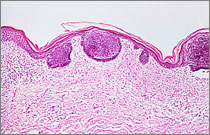Incidence estimation
- Why is cancer incidence estimated for Germany?
- How are incidence rates in Germany estimated?
- Why does the incidence estimate start in 1999?
- How were the rates of new cases of the disease estimated for Germany until 2018?
Why is cancer incidence estimated for Germany?
Since 2009, a nationwide network of epidemiological cancer registries has been collecting data on cancer cases in all German states, and great progress has been made. Nevertheless, the currently available data from some regions of Germany are not yet usable for reliable analysis of cancer incidence.
DCO-Cases
The abbreviation DCO stands for "Death Certificate Only".
A DCO case is an incident cancer case for which a death certificate is the only source of information. Generally, death certificates contain less information about cancer diagnoses than regular notifications. Therefore, the proportion of total cases in a Registry that are DCO cases should be as low as possible.
There are still relevant differences between the registries regarding completeness for some cancer types. This is reflected, for example, in differences in DCO proportions. There are also indications that the transition phase to nationwide clinical-epidemiological cancer registration has led to temporary delays in the registration of new cancer cases in some regions, impacting diagnosis years 2015-2018. Therefore, it is not yet possible to predict exactly when the goal of a nationwide and complete registration of cancer cases in Germany will be achieved and the "estimate" can be replaced with a "count".
An additional aim of the estimate is to derive reliable numbers of incident cancers in Germany for earlier years (starting in 1999) from the available data. Between 1999 and 2009, not all regions of the country conducted cancer registration.
How are incidence rates in Germany estimated?
Based on data from the epidemiological cancer registries in Germany, the Centre for Cancer Registry Data estimates the number of all new cancer cases that occur in Germany each year. The estimation method was revised in 2019 due to observed decreases in incidence associated with the expansion of clinical cancer registration.
According to the revised method, the nationwide incidence is derived from the results of a mixed Poisson regression model. The model takes into account cancer-specific mortality, population size and year of diagnosis. Furthermore, differences in incidence between registries are modelled by random effects. To apply the regression, the data are stratified by sex, registry, diagnosis and age group.
To fit the regression models, data from registries that meet the following quality criteria are used: Coverage for at least 10 years, estimated overall completeness ≥90 percent over at least five years, annual DCO proportion below 15 percent. The first five years of enrollment are excluded, since a substantial proportion of DCO cases in this period are likely to be from years of diagnosis prior to registration, which would lead to an overestimation of incidence.In contrast to the previous estimation method, included DCO cases are counted as regularly reported cases.
Data from complete years from registries meeting the quality criteria are included in the reference region. For registries not yet included in the reference region (Baden-Württemberg, Berlin, Hesse and Saxony-Anhalt), incidence is initially estimated for the years 2011 to 2013 using the ratio of incidence to mortality in the reference region and mortality in the respective federal state. These data are then combined with the data of the reference region to fit the regression models.
The regression coefficients are then used to estimate registry-specific incidence based on mortality rates and year of diagnosis for each cancer type and age group. The nationwide incidence is then calculated by adding together the results obtained for the individual registries.
Why does the incidence estimate start in 1999?
In 2011, the ZfKD modified the procedure for the estimation of completeness. Initially, the ability to depict long-term trends was lost: the new estimation methods for both completeness and incidence can only be applied in this form from 1999 onwards. Estimates calculated based on the new method are not directly comparable with earlier estimates. For the "Bericht zum Krebsgeschehen in Deutschland 2016", a modified estimation method was applied for selected cancer types for the period between 1970 and 1989 and the years 1995-1998.
How were the rates of new cases of the disease estimated for Germany until 2018?
The previous method for incidence estimation was first used to calculate results for “Cancer in Germany 2009/2010”. The nationwide incidence figures were derived according to the results of completeness estimates: for "complete" registries (estimated completeness at least 90 percent), cases were directly counted. For registries with incomplete years of registration, expected values were calculated for those incomplete years. These expected values were derived from the mortality of the respective incomplete registry and the ratio of incidence to mortality from established, complete registries. These expected case counts were then added to the directly counted cases from complete registries.
DCO cases were also included from the complete registries, but only starting from the sixth year of statewide coverage. In the years directly following the start of registration, the DCO proportion tends to be particularly high, since many DCO cases arise from cases diagnosed before the start of the recording. Therefore, DCO proportions from the reference region (by cancer type, age and sex) were applied both to the estimates from incomplete registries as well as to the recorded non-DCO cases from complete registries for the first five years.
Date: 10.11.2020






